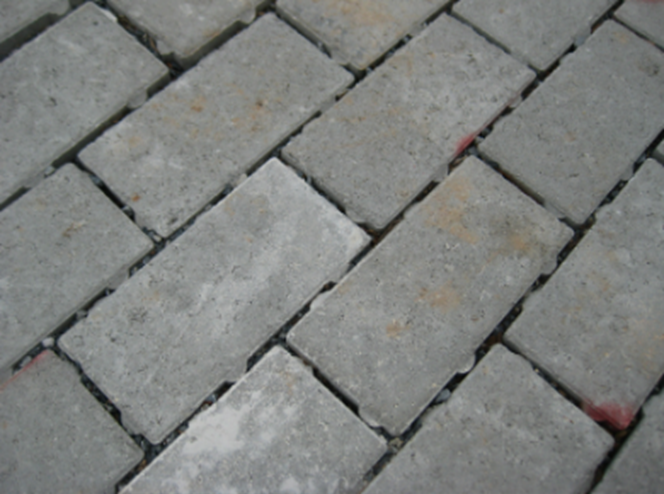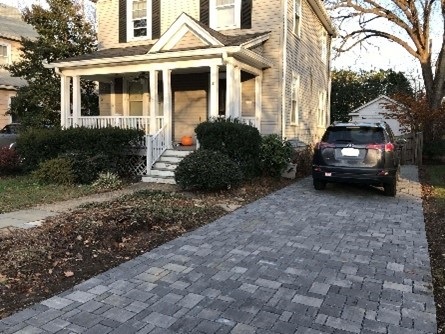Single Family Residential: Permeable Driveway, Patio, Other Surfaces
Courtesy notices regarding recertification have been sent. Please note: Recertification does not begin until November 1, but new photos must be taken during the summer growing season for conservation landscaping and raingardens. Review the credit re-certification guidelines.
For more detailed information, please refer to the Stormwater Credit Manual.
Definition: Permeable pavements are alternative paving surfaces that allow rainfall to filter through voids in the pavement surface into an underlying stone reservoir, where it can soak into the underlying soil.
Guidelines: Replace at least 150 square feet of traditional driveway or other surfaces with permeable pavers or turf block pavers. Other common surfaces for replacement include patios and walkways.
Please note: The minimum qualifying square footage remains 150 square feet with the credit amount remaining at 10%, regardless of whether it is a driveway, patio, or other permeable pavement type (or any combination thereof).
For LDA-permitted homes built from 2021 to the present, eligibility is limited. To qualify, additional paved surfaces must be added after construction. These surfaces are subject to review and approval under an LDA plan revision in accordance with the Stormwater Management Facility Maintenance and Monitoring Agreement.
For properties where total IA, including permeable surfaces, is less than the 75th percentile of their Zoning category, eligibility is limited. The IA coverage limits by zoning category are listed below:
|
Zoning Category
|
Impervious Area limits (square feet)
|
|
R-5
|
2,950
|
|
R-6
|
2,870
|
|
R-8
|
3,515
|
|
R-10
|
4,205
|
|
R-20
|
6,399
|
A permeable paver guidance document is provided to guide your work to achieve the best results. The minimum documentation required to qualify for credit is shown below.
Common Ineligible Pavement Types: Gravel, ribbon, traditional brick, and paver driveways are not eligible for credit.
Existing or New: Both are eligible
Annual or Ongoing credit: Ongoing
Percent Credit: 10% (no duplication)
Minimum: 150 square feet
Frequency of re-certification: Every 2 years
Required Documentation:
|
Documents
|
Additional Information
|
|
- Before photos if newly installed
- If pre-existing, provide the documentation denoted with *
|
 |
- Diagram showing location and surface area*
|
 |
|
- Photos of excavation (minimum 12 inches total)
- 150 square feet minimum area
|
 |
|
- Materials receipts for paver or turf stone materials and stone base (or contractor invoices) * if available for pre-existing
|
Follow manufacturer’s specifications for installation of the permeable pavers or turf block pavers
|
|
- Recent close-up photo of permeable pavers or turf block *
- Recent photo of full permeable driveway area *
- Recent perspective photo of permeable driveway area with nearest structure in background. *
|
  |
|
Credit Re-certification
|
- Recent close-up photo of permeable pavers*
- Recent photo of full permeable driveway area*
- Recent perspective photo of permeable driveway area with nearest structure in background.*
|
  |
Tips for success:
- Be sure to take all required photo types.
- Inspect your pervious surface regularly to evaluate the condition and performance of the pavement. It’s very important to avoid clogging the openings in your pervious surface. These openings allow water to infiltrate and soak into the ground. Don’t use sand or other materials that may clog openings on the pervious surface, and periodically sweep off leaves and other organic debris. Follow any additional manufacturer recommendations for the type of pervious surface installed. The following are annual maintenance tips for permeable pavements:
- Inspect the surface of the permeable pavement for evidence of soil deposits, organic debris, staining or ponding that may indicate surface clogging. If any signs of clogging are noted, use a shop vacuum to remove deposited material. Then, test sections by pouring water from a 5-gallon bucket to make sure they work.
- Inspect the pavement surface, looking for signs of surface deterioration, such as slumping, cracking, spalling or broken pavers. Replace or repair affected areas, as necessary.
- If there is an observation well, check it three days after a rainstorm of ½ inch or more. If standing water is still observed in the well after three days, this is a clear sign that clogging of the soil under the pavement is occurring.
- If applicable, check inlets, pre-treatment cells and any flow diversion structures for sediment buildup and structural damage. Note if any sediment needs to be removed.
- Inspect the areas that drain to the permeable surface for controllable sources of sediment or erosion.
- Typical reasons for denial of re-certification: paver openings are clogged with debris. For turf block pavers, evidence of debris accumulation and/or absence of vegetation.